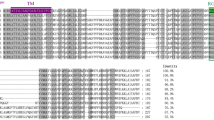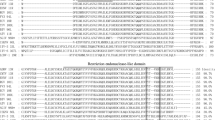Abstract
An essential for respiration and viability (ERV1) homologue, 88R, was cloned and characterized from Rana grylio virus (RGV). Database searches found its homologues in all sequenced iridoviruses, and sequence alignment revealed a highly conserved motif shared by all ERV1 family proteins: Cys-X-X-Cys. RT-PCR and western blot analysis revealed that 88R begins to transcribe and translate at 6 h postinfection (p.i.) and remains detectable at 48 h p.i. during RGV infection course. Furthermore, using drug inhibition analysis by a de novo protein synthesis inhibitor and a viral DNA replication inhibitor, RGV 88R was classified as a late (L) viral gene during the in vitro infection. 88R-EGFP fusion protein was observed in both the cytoplasm and nucleus of pEGFP-N3-88R transfected EPC cells. Although result of immunofluorescence is similar, 88R protein was not detected in viromatrix. Moreover, function of RGV 88R on virus replication were evaluated by RNAi assay. Nevertheless, effect of knockdown of RGV 88R expression on virus replication was not detected in cultured fish cell lines. Collectively, current data indicate that RGV 88R was a late gene of iridovirus encoding protein that distributed both the cytoplasm and nucleus.






Similar content being viewed by others
References
Zhang QY, Li ZQ, Jiang YL, Liang SC, Gui JF (1996) Preliminary studies on virus isolation and cell infection from disease frogs Rana grylio. Acta Hydrobiol Sin 20:390–392
Zhang QY, Li ZQ, Gui JF (1999) Studies on morphogenesis and cellular interactions of Rana grylio virus in an infected fish cell line. Aquaculture 175:185–197. doi:10.1016/S0044-8486(99)00041-1
Zhang QY, Xiao F, Li ZQ, Gui JF, Mao JH, Chinchar VG (2001) Characterization of an iridovirus from the cultured pig frog (Rana grylio) with lethal syndrome. Dis Aquat Organ 48:27–36. doi:10.3354/dao048027
Zhang QY, Zhao Z, Xiao F, Li ZQ, Gui JF (2006) Molecular characterization of three Rana grylio virus (RGV) isolates and Paralichthys olivaceus lymphocystis disease virus (LCDV-C) in iridoviruses. Aquaculture 251:1–10. doi:10.1016/j.aquaculture.2005.05.012
Chinchar VG (2002) Ranaviruses (family Iridoviridae): emerging cold-blooded killers. Arch Virol 147:447–470. doi:10.1007/s007050200000
D’Costa SM, Yao H, Bilimoria SL (2001) Transcription and temporal cascade in Chilo iridescent virus infected cells. Arch Virol 146:2165–2178. doi:10.1007/s007050170027
Lua DT, Yasuike M, Hirono I, Aoki T (2005) Transcription program of red sea bream iridovirus as revealed by DNA microarrays. J Virol 79:15151–15164. doi:10.1128/JVI.79.24.15151-15164.2005
Williams T, Barbosa-Solomieu V, Chinchar VG (2005) Adecade of advances in iridovirus research. Adv Virus Res 65:173–248. doi:10.1016/S0065-3527(05)65006-3
Delhon G, Tulman ER, Afonso CL, Lu Z, Becnel JJ, Moser BA et al (2006) Genome of invertebrate iridescence virus type 3 (Mosquito iridescent virus). J Virol 80:8439–8449. doi:10.1128/JVI.00464-06
Eaton HE, Metcalf J, Penny E, Tcherepanov V, Upton C, Brunetti CR (2007) Comparative genomic analysis of the family Iridoviridae: re-annotating and defining the core set of iridovirus genes. Virol J 4:11. doi:10.1186/1743-422X-4-11
Hagiya M, Francavilla A, Polimeno L, Ihara I, Sakai H, Seki T et al (1994) Cloning and sequence analysis of the rat augmenter of liver regeneration (ALR) gene: expression of biologically active recombinant ALR and demonstration of tissue distribution. Proc Natl Acad Sci USA 91:8142–8146. doi:10.1073/pnas.91.17.8142
Lisowsky T (1992) Dual function of a new nuclear gene for oxidative phosphorylation and vegetative growth in yeast. Mol Gen Genet 232:58–64. doi:10.1007/BF00299137
Lisowsky T, Weinstatsaslow DL, Barton N, Reeders ST, Schneider MC (1995) A new human gene located in the PKD1 region of chromosome 16 is a functional homologue to ERV1 of yeast. Genomics 29:690–697. doi:10.1006/geno.1995.9950
Holmgren A (1985) Thioredoxin. Annu Rev Biochem 54:237–271. doi:10.1146/annurev.bi.54.070185.001321
Afonso CL, Tulman ER, Lu Z, Oma E, Kutish GF, Rock DL (1999) The genome of Melanoplus sanguinipes entomopoxvirus. J Virol 73:533–552
Lewis T, Zsak L, Burrage TG, Lu Z, Kutish GF, Neilan JG et al (2000) An African swine fever virus ERV1-ALR homologue, 9GL, affects virion maturation and viral growth in macrophages and viral virulence in swine. J Virol 74:1275–1285. doi:10.1128/JVI.74.3.1275-1285.2000
Fjose A, Ellingsen S, Wargelius A, Seo HC (2001) RNA interference: mechanisms and applications. Biotechnol Annu Rev 7:31–57. doi:10.1016/S1387-2656(01)07032-6
Agami R (2002) RNAi and related mechanisms and their potential use for therapy. Curr Opin Chem Biol 6:829–834. doi:10.1016/S1367-5931(02)00378-2
Carmichael GG (2002) Silencing viruses with RNA. Nature 418:379–380. doi:10.1038/418379a
Huelsmann PM, Rauch P, Allers K, John MJ, Metzner KJ (2006) Inhibition of drug-resistant HIV-1 by RNA interference. Antivir Res 69:1–8. doi:10.1016/j.antiviral.2005.10.001
Dang LT, Kondo H, Hirono I, Aoki T (2008) Inhibition of red seabream iridovirus (RSIV) replication by small interfering RNA (siRNA) in a cell culture system. Antivir Res 77:142–149. doi:10.1016/j.antiviral.2007.10.007
Xie J, Lü L, Deng M, Weng S, Zhu J, Wu Y et al (2005) Inhibition of reporter gene and Iridovirus-tiger frog virus in fish cell by RNA interference. Virology 338:43–52. doi:10.1016/j.virol.2005.04.040
Tan WG, Barkman TJ, Gregory Chinchar V, Essani K (2004) Comparative genomic analyses of frog virus 3, type species of the genus Ranavirus (family Iridoviridae). Virology 323:70–84. doi:10.1016/j.virol.2004.02.019
Altschul SF, Madden TL, Schäffer AA, Zhang J, Zhang Z, Miller W et al (1997) Gapped BLAST and PSI-BLAST: a new generation of protein database search programs. Nucleic Acids Res 25:3389–3402. doi:10.1093/nar/25.17.3389
Thompson JD, Gibson TJ, Plewniak F, Jeanmougin F, Higgins DG (1997) The ClustalX windows interface: flexible strategies for multiple sequence alignment aided by quality analysis tools. Nucleic Acids Res 24:4876–4882. doi:10.1093/nar/25.24.4876
Edgar RC (2004) MUSCLE: multiple sequence alignment with high accuracy and high throughput. Nucleic Acids Res 32:1792–1797. doi:10.1093/nar/gkh340
Guindon S, Lethiec F, Duroux P, Gascuel O (2005) PHYML Online – a web server for fast maximum likelihood-based phylogenetic inference. Nucleic Acids Res. 33(Web Server issue):W557–W559
Zhao Z, Ke F, Gui JF, Zhang QY (2007) Characterization of an early gene encoding for dUTPase in Rana grylio virus. Virus Res 123:128–137. doi:10.1016/j.virusres.2006.08.007
Willis DB, Foglesong D, Granoff A (1984) Nucleotide sequence of an immediate-early FV3 gene. J Virol 53:905–912
Mao J, Tham TN, Gentry GA, Aubertin AM, Chinchar VG (1996) Cloning, sequence analysis, and expression of the major capsid protein of the iridovirus frog virus 3. Virology 216:431–436. doi:10.1006/viro.1996.0080
Du CS, Zhang QY, Li CL, Miao DL, Gui JF (2004) Induction of apoptosis in a carp leucocyte cell line infected with turbot (Scophthalmus maximus L.) rhabdovirus. Virus Res 101:119–126. doi:10.1016/j.virusres.2003.12.034
Huang XH, Huang YH, Yuan XP, Zhang QY (2006) Electron microscopic examination of the viromatrix of Rana grylio virus in a fish cell line. J Virol Methods 133:117–123. doi:10.1016/j.jviromet.2005.10.029
Coppock DL, Cina-Poppe D, Gilleran S (1998) The quiescin Q6 gene families: thioredoxin and ERV1. Genomics 54:460–468. doi:10.1006/geno.1998.5605
Ellis LBM, Saurugger P, Woodward C (1992) Identification of the three-dimensional thioredoxin motif: related structure in the ORF3 protein of the Staphylococcus aureus mer operon. Biochemistry 31:4882–4891. doi:10.1021/bi00135a020
Senkevich TG, Weisberg AS, Moss B (2000) Vaccinia virus E10R protein is associated with the membranes of intracellular mature virions and has a role in morphogenesis. Virology 278:244–252. doi:10.1006/viro.2000.0656
Senkevich TG, White CL, Koonin EV, Moss B (2002) Complete pathway for protein disulfide bond formation encoded by poxviruses. Proc Natl Acad Sci USA 99:6667–6672. doi:10.1073/pnas.062163799
Epifano C, Krijnse-Locker J, Salas ML, Rodríguez JM, Salas J (2006) The African swine fever virus nonstructural protein pB602L is required for formation of the icosahedral capsid of the virus particle. J Virol 80:12260–12270. doi:10.1128/JVI.01323-06
Wang D, Zhang CX (2006) HearSNPV orf83 encodes a late, nonstructural protein with an active chitin-binding domain. Virus Res 117:237–243. doi:10.1016/j.virusres.2005.10.019
Acknowledgments
This work was supported by grants from the National Major Basic Research Program (2004CB117403), the National 863 High Technology Research Foundation of China (2006AA09Z445, 2006AA100309 and 20060110A4013), the National Natural Science Foundation of China (30671616 and U0631008) and the Key Technology R & D Program of China (2006BAD03B05).
Author information
Authors and Affiliations
Corresponding author
Additional information
The sequence reported in this paper has been deposited in GenBank with the accession number, EU239358.
Rights and permissions
About this article
Cite this article
Ke, F., Zhao, Z. & Zhang, Q. Cloning, expression and subcellular distribution of a Rana grylio virus late gene encoding ERV1 homologue. Mol Biol Rep 36, 1651–1659 (2009). https://doi.org/10.1007/s11033-008-9365-6
Received:
Accepted:
Published:
Issue Date:
DOI: https://doi.org/10.1007/s11033-008-9365-6




